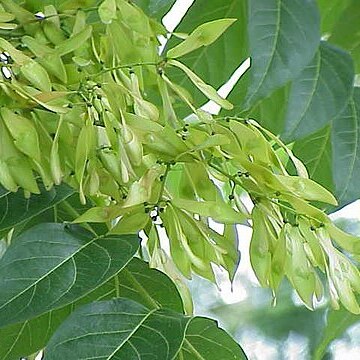Trees or small trees. Branchlets pubescent, with a pith. Leaves alternate, pinnate; leaflets 13-41, opposite or nearly so; blades papery or thinly leathery, base oblique, margin entire or serrate, apex acuminate, base sometimes 1-or 2-dentate on either side, teeth glandular abaxially at apex. Flowers small, polygamo-dioecious, in axillary or terminal thyrses. Sepals 5, imbricate. Petals 5, valvate. Disk 10-lobed. Stamens 10, inserted at base of disk, undeveloped or rudimentary in pistillate flowers. Carpels 2-5, free or slightly connate only at base; ovules 1 or 2 per locule, campylotropous or anatropous; styles 2-5, connate, but only with female trace in male flowers. Samarium oblong-elliptic, with a seed surrounded by wing. Seed flat, rounded, obovate or slightly deltoid, with some endosperm or without; endocarp thin; cotyledons compressed.
Trees, dioecious, evergreen or deciduous. Leaves alternate, pinnate, stipulate or exstipulate; leaflets opposite or subopposite, with abaxial surface glands. Inflorescence an axillary panicle. Calyx 5-, rarely 6-lobed. Petals 5, rarely 6, longer than calyx. Male flowers: stamens 10; filaments without basal appendage; disc 10-lobed; carpels vestigial or absent. Female flowers: stamens reduced or absent; disc 10-lobed; carpels 2–5, free; styles free or connate; ovule 1, pendulous. Fruit a samara. Seed without endosperm.
Trees, usually deciduous. Lvs imparipinnate; leaflets somewhat oblique at base, with a ± conspicuous gland on each side beneath towards the base. Fls in large terminal panicles, ☿ or unisexual. Calyx 5-lobed. Petals 5, valvate, oblong. Stamens 10, inserted at base of 10-lobed disc. Carpels 2-5, connate or free below; styles connate with elongated, divergent stigmas. Fr. a samara, the compressed seed in the middle. Cotyledons suborbicular or broadly ovate.
Incompletely dioecious; fls 5-merous; stamens 10 (fewer or none on fls of female trees); carpels 2–5, united at the axis only, each with a single ovule, maturing into separate samaras with the seed near the center; trees with pinnately compound lvs and malodorous fls in large terminal panicles. 10, Old World.

